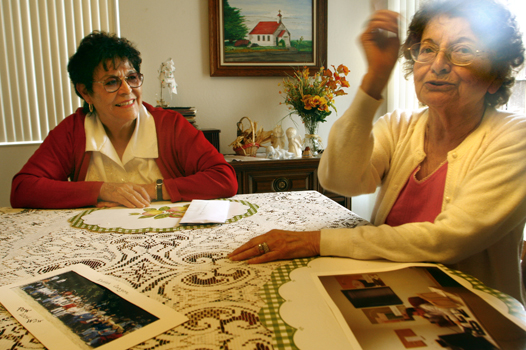
Today’s generation of Native Americans find more acceptance than
their grandparents
Growing up in Santa Rita, an enclave of Salinas close to the
Northridge Mall, Louise Angulo and Delfina Diaz had a family secret
that no one shared openly.
Today’s generation of Native Americans find more acceptance than their grandparents
Growing up in Santa Rita, an enclave of Salinas close to the Northridge Mall, Louise Angulo and Delfina Diaz had a family secret that no one shared openly.
“We never talked about being Indian,” Diaz said. “It had a stigma. If you grew up in Santa Rita, people looked down on you.”
Diaz, 73, and Angulo, 78, grew up in the same neighborhood and said everyone referred to the clan as the Santa Rita Indians in hushed tones.
Both Diaz and Angulo have a mixed heritage, and Diaz jokes that she thought of herself as a Heinz 57 for her Scottish, Irish, Mexican and Indian background.
“My mom was a full-blooded Indian,” said, Angulo, who is also Portuguese. “But we never talked about it until we went and looked at records.”
Angulo and other family members began looking at baptismal records at the Monterey Diocese, birth certificates and death records in the 1970s when the federal government offered money or land as reparation – payment for historical wrongdoing – to certain tribes. The family members received $600 each, but more importantly Angulo discovered her family had been direct descendants of the Espinosa clan.
“They owned property from where Carmel city is today to Big Sur,” Angulo said.
The family is part of the Ohlone tribe – formerly known as Costanoan – a group of Native Americans that lived along the coast from San Francisco to Big Sur.
While the women can point out signs from their childhood of native traditions, most of the culture has been lost.
“The only thing I remember is growing up with Grandpa – he was really our uncle. He had a dark complexion and the hook nose,” Diaz said. “He would take me and my brother out and he would point out different plants. He knew so much, but when you are that young you don’t pay attention.”
Angulo recalls her mother making teas from native plants for stomachaches and other ailments.
“When you have family that passes away, you never think about getting the information,” Diaz said.
In the past few years, the women have had a chance to reconnect with their lost culture with the help of a new generation.
Kanyon Sayers-Roods is one of the young women who honored Diaz, Angulo and dozens of other Ohlone elders at a pow-wow in 2004. Since then, the group has hosted several events in Indian Canyon, a hidden valley in San Benito.
Sayers-Roods upbringing is a stark contrast to that of Diaz and Angulo. The Gavilan College student knows many native songs, dances and even some of the language. She grew up in a remote, but beautiful enclave in San Benito County.
The way Sayers-Roods describes her family home makes it sound like it belongs on a tropical island rather than in central California. To get to Indian Canyon, travelers pass through a vineyard into a secluded canyon that is always lush and green. It has a year-round creek, native plants and seven flowing waterfalls.
Though she admits living in a secluded area without electricity wasn’t always fun, she believes it helped shape who she is today.
“When I was younger it was kind of a drag with no electricity,” she said. “But now it helps because all those modern conveniences make people a little less who they are.”
Growing up with her mother, Ann Marie Sayers and other family, Sayers-Roods always knew she was Native American.
“I knew early on through going to a lot of Native American events and partaking in ceremonies,” she said. “And because of my mother being so proud.”
Though she experienced some of the nasty comments children can make, she now talks openly about her heritage with friends and classmates.
“On my first day of school, my mother says I came home crying and she asked why,” Sayers-Roods said. “An older student said if I was Indian, I must be dead.”
Her mother tickled her and told her as long as she was laughing she must be alive. The incident opened up a dialogue with teachers to talk about existing Native Americans.
At the pow-wow in 2004, Sayers-Roods and other girls made bead necklaces to honor the elders, taught them native songs and danced for them.
“In the beginning it felt like another thing my mom wanted me to be involved in,” she said. “But when I realized these elders were not identified as natives throughout their lives it helped me to want to bring out the culture.”
She practiced a rain dance and said every time she performed it rain fell from the sky.
“It was nice talking about the history,” Diaz said. “Everyone wants to know who they are and where their ancestors came from.”
Melissa Flores can be reached at mf*****@**********ws.com.









